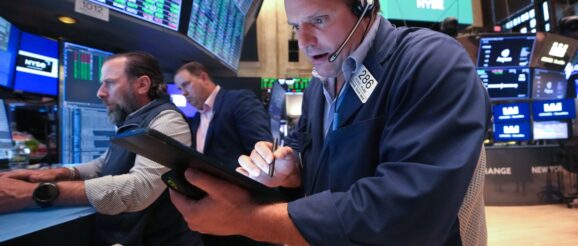Stocks soar after U.S., China agree to cut tariffs for now

Stocks opened sharply higher Monday after the U.S. and China announced a temporary break from triple-digit tariffs that had brought much of the trade between the two countries to a standstill in recent weeks.

The Dow Jones Industrial Average soared more than 1,000 points, or around 2.5%, shortly after the opening bell, while the S&P 500 index gained 2.6%.
The surge in stocks come after the two countries agreed to slash the crippling tariffs for 90 days following talks in Geneva over the weekend. The tax on Chinese imports to the U.S. will drop from 145% to 30% while the tariff China charges on U.S. goods will fall from 125% to 10%.
The pause comes after many businesses that rely on imports had halted deliveries to avoid paying a triple-digit tax. Cargo traffic at the Port of Los Angeles last week had fallen by more than a third from a year ago, raising the prospect of supply shortages in the near future.
The remaining tariffs are still significantly higher than Americans were used to paying, however, before President Trump launched his trade war. And because the tariff relief has an expiration date while negotiations continue, there is still considerable uncertainty over what the trade landscape will look like in three months.
“It was a great relief for about five minutes,” says Bonnie Ross, a clothing importer, based in New York.
Ross had pulled two cargo containers off ships in China when the 145% tariffs took effect. Now she’s scrambling to get as much merchandise to the U.S. as she can while the lower tariffs are in place.
“Now it’s going to be a rush because everybody wants it out in the next 90 days,” Ross says. “What is going to happen to the freight rates?”
“We’ve been holding everything at the factories and at the ports, because we didn’t want risk putting anything on containers with a 145% tariff,” Foreman says.
He says a 30% import tax is more manageable, although at least some of that cost will have to be passed on to consumers in the form of higher prices.
“It’s a complete disruption, but obviously I’m sure everybody in the supply chain would agree it’s better than it was,” Foreman says.
Some businesses may race to produce and ship products early for the Christmas holiday season to avoid the risk of higher tariffs in the fall. But that’s also a gamble, Foreman says, because it’s possible the administration will order lower tariffs at the end of the three-month window.
“Right now, I’m just trying to get through the next four to six weeks,” he says. “Whether I double-shift the factories to try to get more produced and out the door before the end of the 90 days, I’ll probably need another three to four weeks to figure that out.”
